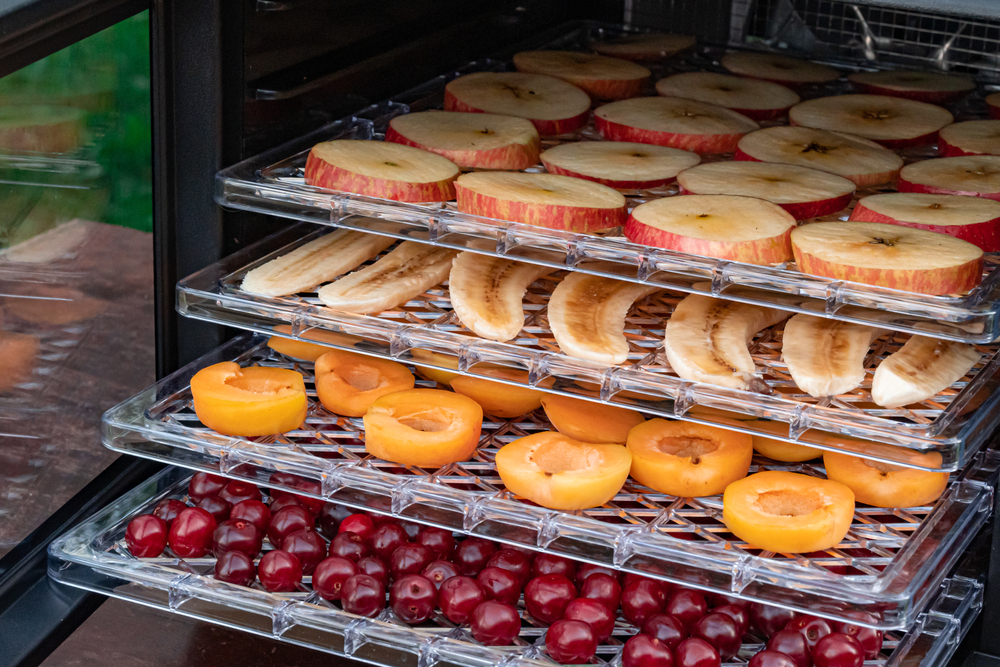Last Updated on March 12, 2023 by admin_hunter
You may wonder how much survival food you need? The answer to this question depends on your age, body weight, and activity level. A normal adult will need around 2,000 calories to stay healthy.
The most important thing is to make sure your food supply is healthy and nutritious. It should also have a long shelf life. This will help you get through a disaster and have food to eat for a long time.
Dehydrated Fruits
Dried fruits are a great way to add nutrients and flavor to your food storage, whether you’re planning for an emergency or a long-term prep. They can be added to soups, baked into pies and even incorporated into your favorite granola or trail mix.
Dried fruit also lasts for a much longer period of time than fresh fruits do because it drastically reduces its moisture content. In fact, dried fruit can have a shelf life of up to 5 years or more with proper care.
When dehydrating fruits, choose high-quality produce that was picked when ripe. Generally, ripe fruit is sweeter and carries more vitamins and minerals than other types of produce. Peel or core if necessary and slice into an even thickness (removing pits, if present). Place on dehydrating trays at 135 to 145 F until dry and pliable.
After drying, keep the jars in a cool and dark place to prevent oxidation and to ensure a consistent quality of your dehydrated foods. You can also reduce oxidation by using airtight containers and vacuum sealing them with oxygen absorber packets.
Depending on the type of fruit you dehydrate, it may take anywhere from 6 to 16 hours for most fruits to dry thoroughly. During this time, monitor the fruits to make sure they are drying evenly. Check them every 2 to 3 hours as needed, rotating trays as necessary.
Nuts
Nuts are a popular component of any survival diet. Not only are they tasty but they also offer a variety of nutrients, including dietary fiber, protein, vitamins, minerals, antioxidants, and fat. Some of the most popular nuts include walnuts, pistachios, peanuts, macadamias, and hazelnuts.
For the most part, nut products are easy to store and provide you with plenty of energy to get through any disaster that comes your way. They may not be the most exciting survival food to eat but they are a great way to keep your belly full during a crisis.
It is also possible to find a high quality trail mix with a reasonable price tag. Using a combination of nuts and dried fruit, this snack offers some serious calories, while the fact that it can be eaten on the go has to be lauded as well.
In the end, there is no single answer to the question, “What are the best survival foods?” You need to be able to choose from a large array of options. The most important rule of thumb is to make sure you have an equal number of each category in your arsenal. You should never carry only one type of item at a time, and rotate your stash regularly so it always remains fresh.
Meat
One of the most important aspects of preparing for a disaster is ensuring that you have a stockpile of survival food. This will give you the energy and nutrients you need to get through a crisis until the power comes back on.
Typically, you won’t need to have more than a day’s supply of survival food. You can start by looking at how much food you have in your home for a family of four.
When it comes to long-term food storage, you should build your stash around staples like rice, beans and wheat. These foods are low cost, have a good nutritional value and can last up to 10 years if stored properly.
In addition to these basics, you should also include salt and sugar in your stash of survival food. Both of these can last for up to 10 years, and they are a great way to add flavor and calories to your meals.
Then, you should also consider adding a variety of vegetables to your stockpile. Vegetables provide the vitamins and minerals that you need to stay healthy in a survival situation.
Finally, you should stock up on canned meats and small cans of meat that can be eaten quickly without leftovers. Canned meats and fish are a good choice for survival situations because they contain the nutrients you need to survive and are easy to prepare.
Vegetables
In a survival situation, you need food that provides calories and nutrients. That means you need to include both starchy and non-starchy vegetables in your stockpile. These foods are packed with vitamins and minerals that can help you recover from an injury or illness.
Vegetables are also good sources of protein and fiber. They can be cooked or eaten raw in a pinch, and they can be prepared with a variety of spices.
During an emergency, it is important to choose foods that you and your family enjoy. This will help ensure that everyone has a consistent diet and stays healthy during the crisis.
When choosing your survival foods, you should choose items that have a long shelf life. This will reduce the risk of spoiling or contamination.
Many dried and canned goods can be stored for years, but you should always check their expiration dates to make sure they are still good.
Some of the most common survival foods that are easy to store include rice, beans, wheat, and pasta. These foods can be cooked in a variety of ways and have an impressive shelf life when properly stored.
In addition to these items, you should stock up on vegetables and fruit that have a high water content. These foods can help you hydrate during an emergency, and they are also low in sugar and calories.
Fruit Juices
If you are in the wilderness, you need to have enough food and water. But, you also need to be able to create a source of energy. Fruit juices can be a good source of energy. However, they are also high in sugar and calories. You should drink only small amounts of these drinks because they can cause weight gain and other health problems.
There are several different types of fruit juices, each with their own set of benefits. Some are better than others for your health, depending on the type of fruit and what nutrients are lost during processing.
For example, pomegranate juice is known to decrease blood pressure and improve cholesterol levels. This is mainly because pomegranate juice is rich in potassium and can reduce your risk of heart disease and stroke.
However, it is important to choose a quality product and be sure it has been pasteurized. This will kill any bacteria that might be in the juice and be safe for you to consume.
Another benefit of pomegranate juice is that it contains a lot of antioxidants, like lutein and zeaxanthin. These antioxidants can help to prevent cancer and other diseases, as well as slow down the aging process.
In general, fruit juices contain more than one nutrient and provide a range of vitamins, minerals, and other micronutrients. For example, orange juice is rich in vitamin C and folate.
Water
Water is an essential component of survival food. It hydrates, cleans and sanitizes your body and is also used for washing, cooking and hygiene.
The average person needs between 1 and 2 quarts of water each day to stay hydrated. However, children and pregnant women need more and ill people may need up to 4 quarts of water each day.
Drinking water is an important part of any emergency supply and should be stored in a safe place. It is best to store it in plastic containers with tight fitting lids or screw tops.
Disaster experts recommend storing at least 14 gallons of water per person for a 2-week supply. If possible, store more for hot climates and if your family is sick or has babies.
Keep in mind that water can be contaminated by bacteria and viruses, so it is advisable to purify the water before using it. Commercially bottled water is the most reliable source of clean, potable water.
If you don’t have access to bottled water, consider obtaining a container of unopened drinking water and storing it in a dry, cool area. You can purchase cases of bottled water for relatively cheap from a grocery or warehouse store and one case is equal to about three gallons of water.
It is important to keep in mind that a lack of hydration will not only dehydrate you, but it will also make it more difficult for you to digest foods. This is because the kidneys use water to help digest carbohydrates and protein.

